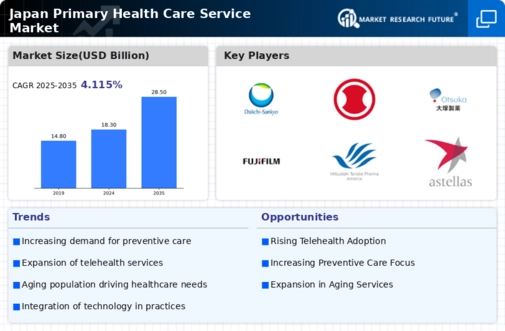Rising Healthcare Expenditure
The primary health-care-service market in Japan is experiencing a notable increase in healthcare expenditure, driven by the growing demand for quality medical services. In recent years, healthcare spending has risen to approximately 10% of GDP, reflecting the government's commitment to enhancing health services. This trend is likely to continue as the population ages and the prevalence of chronic diseases increases. The rising expenditure is expected to facilitate investments in advanced medical technologies and infrastructure, thereby improving service delivery in the primary health-care-service market. Furthermore, the increased funding may lead to better training for healthcare professionals, ultimately enhancing patient care and outcomes. As a result, the primary health-care-service market is poised for growth, with stakeholders likely to benefit from the enhanced financial resources allocated to healthcare.
Increased Focus on Preventive Care
There is a growing emphasis on preventive care within the primary health-care-service market in Japan. This shift is largely influenced by the recognition that early intervention can significantly reduce the burden of chronic diseases. Government initiatives and public health campaigns are promoting regular health screenings and lifestyle modifications, which are expected to enhance overall population health. Data indicates that preventive care measures can lead to a reduction in healthcare costs by up to 20%, as they help avoid more expensive treatments for advanced conditions. Consequently, healthcare providers are likely to adapt their services to prioritize preventive strategies, thereby reshaping the landscape of the primary health-care-service market. This focus on prevention may also foster greater collaboration between various healthcare stakeholders, including public health organizations and private providers.
Expansion of Health Insurance Coverage
The expansion of health insurance coverage is a critical driver for the primary health-care-service market in Japan. Recent reforms have aimed to increase access to healthcare services for a broader segment of the population. With approximately 98% of the population now covered by some form of health insurance, the financial barriers to accessing primary care are diminishing. This increased coverage is likely to result in higher utilization rates of healthcare services, as individuals are more inclined to seek medical attention when needed. Furthermore, the government is actively working to enhance the quality of care provided under insurance plans, which may lead to improved patient outcomes. As a consequence, the primary health-care-service market is expected to expand, driven by the growing number of insured individuals seeking comprehensive healthcare services.
Growing Demand for Personalized Medicine
The primary health-care-service market in Japan is shifting towards personalized medicine, driven by advancements in genomics and biotechnology. Patients are increasingly seeking tailored treatment plans that consider their unique genetic profiles and health histories. This trend is supported by the rising awareness of the limitations of one-size-fits-all approaches in healthcare. As a result, healthcare providers are likely to invest in genetic testing and personalized treatment options, which could enhance patient outcomes and satisfaction. The market for personalized medicine is projected to grow significantly, with estimates suggesting a potential increase of over 15% annually. This evolution in treatment paradigms may lead to a more effective and efficient primary health-care-service market, ultimately benefiting both patients and providers.
Technological Advancements in Healthcare
Technological innovations are significantly impacting the primary health-care-service market in Japan. The integration of telemedicine, electronic health records, and mobile health applications is transforming how healthcare services are delivered. For instance, the adoption of telehealth services has surged, with estimates suggesting that around 30% of consultations are now conducted remotely. This shift not only improves access to care, especially in rural areas, but also enhances patient engagement and satisfaction. Moreover, advancements in diagnostic tools and treatment methodologies are likely to lead to more efficient healthcare delivery. As technology continues to evolve, the primary health-care-service market is expected to adapt, potentially resulting in improved health outcomes and reduced costs for patients and providers alike.

















Leave a Comment